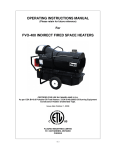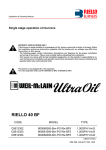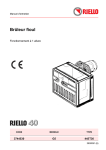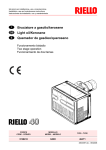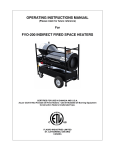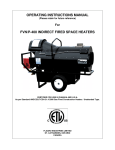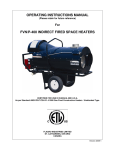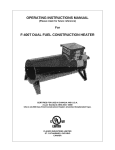Download OPERATING INSTRUCTIONS MANUAL FVO-750
Transcript
OPERATING INSTRUCTIONS MANUAL (Please retain for future reference) For FVO-750 INDIRECT FIRED SPACE HEATERS CERTIFIED FOR USE IN CANADA AND U.S.A. As per CSA B140.8 Portable Oil Fired Heaters / CSA B140.02003 Oil Burning Equipment Construction Heaters Unattended Type. Issue date July 1, 2012 FLAGRO INDUSTRIES LIMITED ST. CATHARINES, ONTARIO CANADA -1- GENERAL HAZARD WARNING: FAILURE TO COMPLY WITH THE PRECAUTIONS AND INSTRUCTIONS PROVIDED WITH THIS HEATER, CAN RESULT IN DEATH, SERIOUS BODILY INJURY AND PROPERTY LOSS OR DAMAGE FROM HAZARDS OF FIRE, EXPLOSION, BURN, ASPHYXIATION, CARBON MONOXIDE POISONING, AND/OR ELECTRICAL SHOCK. ONLY PERSONS WHO CAN UNDERSTAND AND FOLLOW INSTRUCTIONS SHOULD USE OR SERVICE THIS HEATER. THE IF YOU NEED ASSISTANCE OR HEATER INFORMATION SUCH AS AN INSTRUCTIONS MANUAL, LABELS, ETC. CONTACT THE MANUFACTURER. WARNING: FIRE, BURN, INHALATION, AND EXPLOSION HAZARD. KEEP SOLID COMBUSTIBLES, SUCH AS BUILDING MATERIALS, PAPER OR CARDBOARD, A SAFE DISTANCE AWAY FROM THE HEATER AS RECOMMENDED BY THE INSTRUCTIONS. NEVER USE THE HEATER IN SPACES WHICH DO OR MAY CONTAIN VOLATILE OR AIRBORNE COMBUSTIBLES, OR PRODUCTS SUCH AS GASOLINE, SOLVENTS, PAINT THINNER, DUST PARTICLES OR UNKNOWN CHEMICALS. WARNING: NOT FOR HOME OR RECREATIONAL VEHICLE USE. WARNING: INTENDED USE IS PRIMARILY THE TEMPORARY HEATING OF BUILDINGS UNDER CONSTRUCTION, ALTERATION, REPAIR OR EMERGENCIES ONLY. -2- This heater is designed and approved for use as a construction heater under CSA B140.8 Portable Oil Fired Heaters / CSA B140.02003 Oil Burning Equipment. We cannot anticipate every use which may be made of our heaters. CHECK WITH YOU LOCAL FIRE SAFETY AUTHORITY IF YOU HAVE QUESTIONS ABOUT APPLICATIONS. Other standards govern the use of fuel gases and heat producing products in specific applications. Your local authority can advise you about these. SPECIFICATIONS Model …………………………………………………….…. FVO-750 Input …………………………………………………….…... 750,000 btuh Fuel …………………………………………………………. No.1, No. 2, Diesel or Kerosene Fuel Pressure …………………………………………….... 160 psi Nozzle ………………………………………………………. 4.50 x 60W (Delavan) Ignition ………………………………………………………. Direct Spark …….……………………………………………...…. Thermostat Control Air Circulation ………………………………………………. 7000 cfm Fuel Consumption ………………………………………...... 5.42 Gal/hr Approved …………………………………………………...... cETLus listed -3- INSTALLATION: The installation of this heater for use with No.1, No.2, Diesel or Kerosene and shall conform with local codes or, in the absence of codes, with the National Fuel Gas Code ANSI Z223.1/NFPA 54. Installation of the unit shall be in accordance with the regulations of the authorities having jurisdiction or the CSA Standard B139. CLEARANCE TO COMBUSTIBLES: TOP FRONT SIDES REAR FLUE PIPE 1 ft 1 ft 1 ft 2 ft 2 ft FUEL: This heater will operate with No.1, No.2, Diesel or Kerosene. Note: No.1 Fuel Oil or Kerosene must be used for temperatures less than –10º C (8º F). ELECTRICAL: This appliance is equipped with a grounded receptacle for your protection against shock hazard and should be plugged directly into a properly grounded plug. The electrical grounding of the heater shall be in compliance with the National Electrical Code, ANSI/NFPA 70, or CSA C22.1, Canadian Electrical Code, Part I. THIS APPLIANCE WILL OPERATE WITH 1 PHASE OR 3 PHASE POWER. 208V-230V SUPPLY MUST BE AVAILABLE. POWER SUPPLY: SINGLE PHASE: 208V-230V, 30AMP BREAKER OR 30 AMP TIME DELAY FUSE, 8/3 AWG AT 100FT MAX. OR THREE PHASE: 208V-230V, 25AMP BREAKER OR 25AMP TIME DELAY FUSE, 10/4 AWG AT 100FT MAX. **POWER CORD PLUG ENDS PROVIDED WITH UNIT FOR 1 PHASE OR 3 PHASE OPERATION This heater is equipped with a VFD “Variable Frequency Drive” to control the primary fan acceleration & de-acceleration. The VFD has been password protected to prevent improper use. If access to VFD controls is required for troubleshooting, please contact manufacture for assistance. -4- FLUE PIPE: For outdoor applications the flue pipe connection must terminate with a vertical run of at least 2ft complete with rain cap. For indoor installations the venting must consist of a minimum 2ft vertical run to a maximum of 20ft total vent length. See diagram below for horizontal vent installation. The vent outlet on the heater is 8” diameter. Certified venting must be used at all times. Vent cap must be installed in situations where downdrafts occur. All venting must correspond with the CSA B149 standard or in its absence, local codes. FLUE TERMINATIONS C B 90 DEG ELBOW 45 DEG ELBOW A EXTERIOR WALL FLUE OUTLET OF HEATER A - Vertical vent run must be a minimum of 2ft from heater outlet. B - Maximum horizontal run is 20ft Note: 90deg Elbow = 5ft C - Vent termination in horizontal position must be minimum 2ft from wall. A 45deg elbow is recommended at horizontal termination. Note: Horizontal flue run - Rise ratio 1:10. -5- DUCTING: Heater duct with a minimum temperature rating of 300 deg F including wire reinforcement to prevent collapsing. Heater is designed for use with 2 x 16” diameter ducts equipped with gear clamp couplings (FV-HD16X25B). Install ducting to the heater outlet using gear clamps provided on the collar of the ducting. Ducting should be inspected periodically for tearing and/or wear marks. Ducting should be stored in a dry area when not in use MAINTENANCE: 1. Every construction heater should be inspected before each use, and at least annually by a qualified service person. Incorrect maintenance my result in improper operation of the heater and serious injury could occur. 2. Service and Maintenance only to be performed by a qualified service person. 3. The hose assemblies shall be visually inspected prior to each use of the heater. If it is evident there is excessive abrasion or wear, or the hose is cut, it must be replaced prior to the heater being put into operation. The replacement hose assembly shall be that specified by the manufacturer. 4. The flow of combustion and ventilation air must not be obstructed. Be sure to check the fan assembly and ensure that the motor and blade are operating properly. 5. Compressed air should be used to keep components free of dust and dirt build up. Note: Do not use the compressed air inside any piping or regulator components. 6. Change fuel filter insert (Part# FVO-419) once per month. Change fuel filter cartridge (Part# FVO-418) once every 6 months. 7. Change oil nozzle (Part# FV-738) once per year. 8. High Limit Switches (Part# FV-706 & FV-707) should be checked each season. These limit switches will ensure the burner shuts down if the temperature exceeds 200º F at rear of unit and 250º F at the outlet. 9. Heat Exchanger should be cleaned if smokey conditions continue even after the air adjustments on the burner are made. -6- START UP INSTRUCTIONS: 1. Position heater properly & on a level surface before operating 2. Connect Fuel supply to heater 3. Ensure the (Thermostat / Manual) selector switch is in the “OFF” position 4. Attach power supply, 208-230V/1-phase or 208-230V/3-phase to appropriate receptacle. 5. Turn disconnect switch (Single or Three phase) depending on power supply to “ON” position. 6. Move switch to “MANUAL” position for manual control. “OR” 7. Move switch to “THERMOSTAT” position for thermostatic control. Please Note: 1. If using Thermostat kit, the heater must be started in Thermostat position. 2 When changing between manual and thermostat operation, the heater must be left in the “OFF” position until blower fan completely shuts down before changing position to prevent the burner from locking out. 3. When using a generator for electrical supply, make sure the generator is properly grounded and is at a 60Hz frequency. 4. In the event that a Generator is being used and runs out of fuel, make sure the heater switch is in the “OFF” position before restarting generator, failure to do so may damage heater. TO SHUT DOWN: 1. Close main fuel supply valve 2. Move Thermostat/Manual switch to “OFF” position. 3. Waiting until blower fan shuts down (3 minutes approx.) -7- 4. Turn Disconnect switch (single phase or three phase) depending on power supply to “OFF” position. 5. Turn main power breaker to “OFF” position 6. Disconnect heater from fuel supply. IF HEATER FAILS TO START: 1. Press manual reset button at rear of burner. 2. Check fuel level. There must be 6-8 gallons of fuel in the tank for the heater to start properly. 3. Make sure there are no air locks in fuel lines or filter. 4. Ensure proper power supply is being used. 5. Check for dirty fuel filter or blocked fuel supply line. 6. Check burner nozzle assembly. NOTE: IF THE BURNER HAS BEEN RESET SEVERAL TIMES THERE MAY BE AN ACCUMULATION OF OIL IN THE CHAMBER! DO NOT CONTINUE TO TRY AND START THE HEATER! DRAIN OIL FROM HEAT EXCHANGER USING DRAIN HOLE AT FRONT OF HEAT EXCHANGER FOR 15-20 MINUTES BEFORE ATTEMPTING TO RELIGHT. LET REMAINING EXCESS OIL BURN OFF BEFORE CHECKING COMBUSTION OF UNIT. -8- SAFE OPERATION PRECAUTIONS: 1. Do not fill external fuel tank while heater is in operation. 2. Do not attempt to start heater if excess oil remains in the heat exchanger. 3. Use selector switch to shut down the heater. Do not try to shut down the heater by unplugging the electrical cord. Note: DAMAGE TO THE HEATER WILL OCCUR 4. Do not plug anything other than the thermostat into the “Thermostat” plug. 5. Do not use any fuel other than those listed on rating plate. 6. Follow electrical requirements shown on rating plate and/or Electrical requirements section of this manual. 7. Before removing any guards or performing any maintenance, be sure that the main power supply is disconnected. 8. All external fuel supply tanks must include a vent. -9- COMBUSTION AIR ADJUSTMENTS: NOTE: Proper combustion air adjustment must be achieved using a certified combustion analyzer and smoke tester to ensure complete combustion. The air adjustment should be made to achieve 10% CO2 and No. 1 or “trace” smoke. (Bacharach Scale) AIR SHUTTER SETTING LOW FIRE SETTING A) Loosen PRESSURE RELEASING SCREW (1). (One turn is sufficient). This permits the fuel pressure to bleed off to the pump return port and the burner to operate continuously at the low fire rate. B) Loosen RETAINING NUT (2). C) Turn the ADJUSTING SCREW (3) until the top of the air shutter (9) is correctly positioned according to the Burner Set-up Chart. D) Use instruments to establish the proper settings for maximum CO2 and a smoke reading of zero. E) Hold ADJUSTING SCREW (3) in position and secure by tightening RETAINING NUT (2). - 10 - F) Retighten PRESSURE RELEASE SCREW (1). Note: The low fire pressure regulator is pre-set at the factory to 100 PSI (7 bar). To vary or regulate this pressure it is necessary to attach a pressure gauge to the PRESSURE PORT (6). Loosen the PRESSURE RELEASE SCREW (1) as in step A above. Regulate the pressure by turning the PRESSURE REGULATING SCREW (5). The corresponding pressure can be read on the pressure gauge attached to the PUMP PRESSURE PORT (6). MAIN FLAME SETTING A) Be sure that the burner is operating at high fire. B) Set the pump pressure by attaching a pressure gauge to the Pressure port (6) and adjust the pressure by turning the pressure regulator adjustment screw (10). Loosen the RETAINING NUT (7), and turn the BOLT (8) in a counterclockwise direction until about 3/4 of an inch of thread is visible. Using the setting taken from the Burner Set-up Chart, column 5, position the air shutter (9) so that the top of the shutter is aligned with the proper index line indicated on the air intake side of the burner housing. Holding the shutter in this position, turn ADJUSTING BOLT (8) in a clockwise direction until a resistance is met. C) The final position of the air adjustment plate will vary on each installation. Use instruments to establish the proper settings for maximum CO2 and a smoke reading of zero. NOTE: Variations in flue gas, smoke, CO2 and temperature readings may be experienced when the burner cover is put in place. Therefore, the burner cover must be in place when making the final combustion instrument readings, to ensure proper test. - 11 - BURNER SET-UP CHART 1 2 3 4 ACTUAL FIRING RATE ± 5% NOZZLE SIZE GPH GPH PSI BAR 5.42 4.50 x 60°W 160 11 PUMP PRESSURE TURBULATOR SETTING 5 5 AIR DAMPER SETTING 5 * Note – Air damper setting is typically set at 5 for operation in colder temperatures. A combustion analyzer should always be used when setting the burner. - 12 - ELECTRICAL CONNECTIONS It is advisable to leave the control box off the sub-base while completing the electrical connections to the burner. Using the appropriate diagram below, make electrical connections to the burner. All wiring must be done in accordance with existing electrical codes, both national and local. When all electrical connections have been made, the control box may be put back in place on the sub-base. WARNING: DO NOT activate burner until proper oil line connections have been made, or failure of the pump shaft seal may occur. - 13 - REMOTE SENSING OF SAFETY LOCKOUT: The SAFETY SWITCH in the 530SE CONTROL BOX is equipped with a contact allowing remote sensing of burner lockout. The electrical connection is made at terminal 4 (●) on the SUBBASE. Should lockout occur the 530SE CONTROL BOX will supply a power source of 120Vac to the connection terminal. The maximum allowable current draw on this terminal (4) is 1 Amp. WARNING: If a neutral or ground lead is attached to this terminal, the CONTROL BOX on the burner will be damaged should lockout occur. - 14 - INSERTION / REMOVAL OF DRAWER ASSEMBLY A) To remove drawer assembly, loosen SCREW (3), then unplug CONTROL BOX (1) by carefully pulling it back and then up. B) Remove the AIR TUBE COVER PLATE (5) by loosening the two retaining SCREWS (4). C) Loosen SCREW (2), and then slide the complete drawer assembly out of the combustion head as shown. D) To insert drawer assembly, reverse the procedure in items A to C above, and then attach fuel line to the pump. - 15 - NOZZLE PLACEMENT A) Remove the NOZZLE ADAPTER (2) from the DRAWER ASSEMBLY by loosening the SCREW (1). B) Insert the proper NOZZLE into the NOZZLE ADAPTER and tighten securely (Do not over tighten). C) Replace adapter, with nozzle installed, into drawer assembly and secure with screw (1). ELECTRODE SETTING - 16 - TURBULATOR SETTING A) Loosen NUT (1), then turn SCREW (2) until the INDEX MARKER (3) is aligned with the correct index number as per the Burner Set-up chart, on page 12. B) Retighten the RETAINING NUT (1) NOTE: Zero and five are scale indicators only. From left to right, the first line is 5 and the last line 0. OIL LINE CONNECTIONS Note: Pump pressure must be set at time of burner start-up. A pressure gauge is attached to the PRESSURE PORT (8) for pressure readings. Two PIPE CONNECTORS (5) are supplied with the burner for connection to either a single or a two-pipe system. Also supplied are two ADAPTORS (3), two female 1/4” NPT, to adapt oil lines to burner pipe connectors. All pump port threads are British Parallel Thread design. Direct connection of NPT threads to the pump will damage the pump body. Riello manometers and vacuum gauges do not require any adaptors, and can be safely connected to the pump ports. An NPT (metric) adapter must be used when connecting other gauge models. - 17 -


















